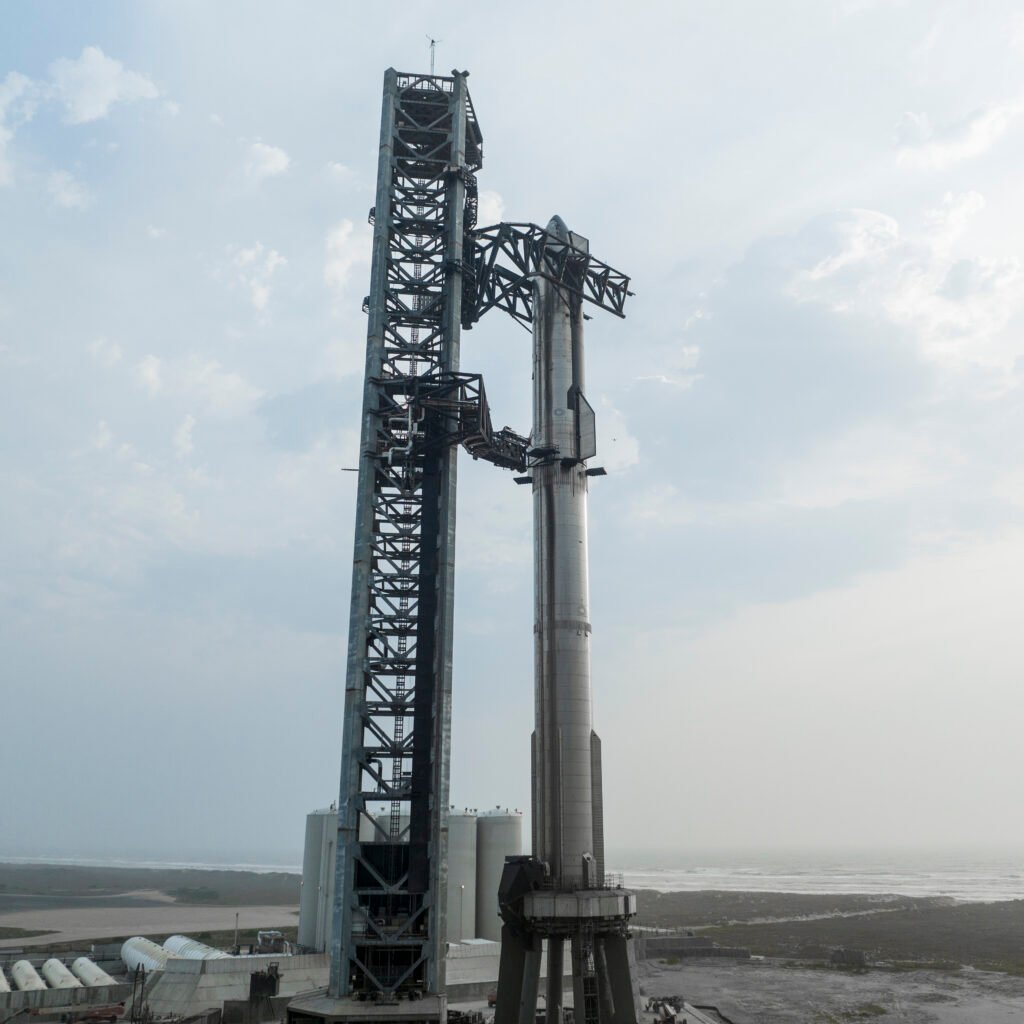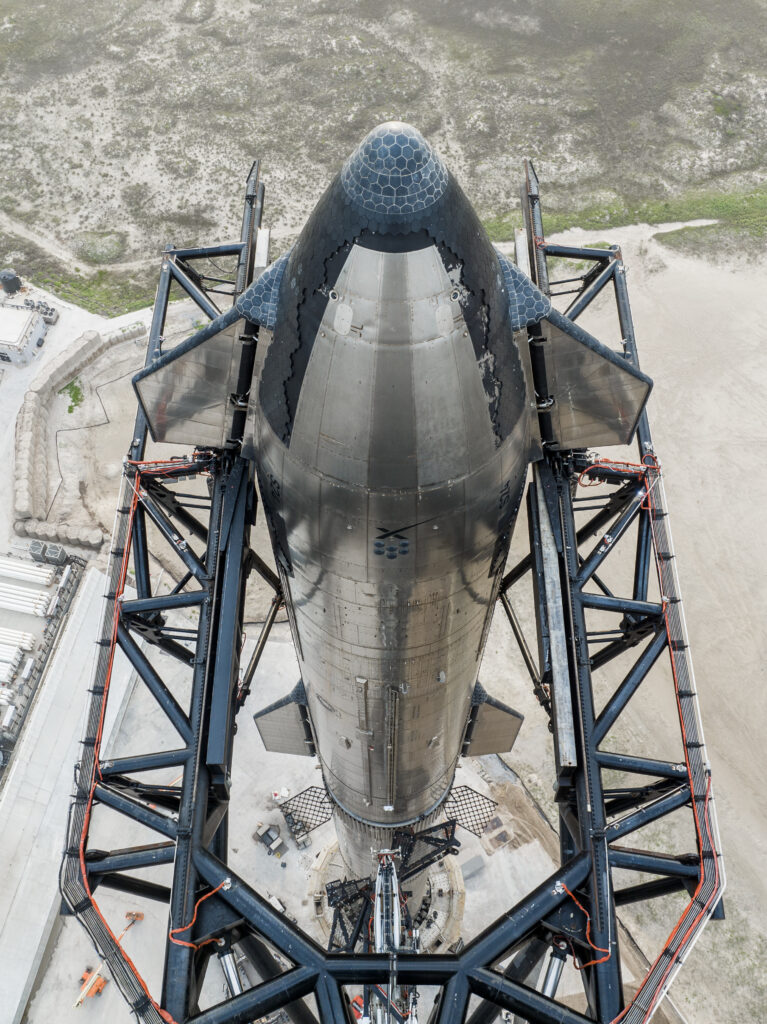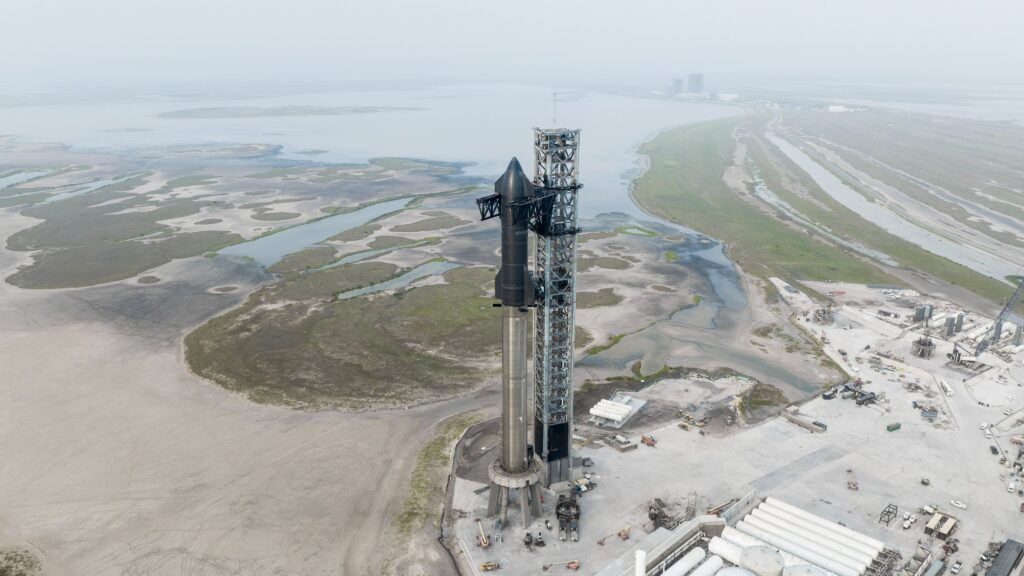SpaceX’s Starship vehicle is a sight to behold in the latest photos released on Twitter.
The fully stacked stainless-steel rocket stands tall at the Starbase facility in South Texas ahead of its first-ever orbital test flight. The rocket’s upper-stage prototype, Ship 24, was stacked atop the first-stage booster, Booster 7, on April 5.
The Starship vehicle, standing at a towering 394 feet (120 meters) tall, is a combination of a Starship upper stage atop a Super Heavy booster. This will make it the most powerful rocket launched once it takes off. The missile can carry up to 150 metric tons to low Earth orbit and will be fully reusable, making space travel more affordable.



SpaceX’s founder and CEO Elon Musk has suggested an even more accelerated timeline for the launch, stating that it could happen as soon as next week if regulatory approvals come through. However, the U.S. Federal Aviation Administration (FAA) has set a provisional launch window for April 17, between 7:00 and 11:00 a.m. EDT, and the FAA still needs to issue a launch license for the Starship flight.
SpaceX has high hopes for Starship, with plans to carry people and cargo to the Moon and Mars. In fact, NASA has already picked Starship to be the first crewed lander for its Artemis moon exploration program, with an initial astronaut touchdown planned for 2025. Additionally, private customers have already booked rides on the Starship, including Japanese billionaire Yusaku Maezawa, who will take a trip around the Moon with a crew of eight artists, and American engineer and entrepreneur Dennis Tito, who plans to fly on a circumlunar mission with his wife and other passengers yet to be named.
The Starship vehicle represents a significant leap forward in space travel, and we can’t wait to see it take off on its first-ever orbital test flight.
Discovering SpaceX Starship: The Journey to Revolutionize Space Exploration
SpaceX has made impressive progress in bringing Starship into reality. Plans to create a heavy-lift launch vehicle at SpaceX date way back to 2005, and while its’ methane–oxygen engines were in development by 2012, the plan was only announced publicly for the first time in 2016.
In July 2021, SpaceX made a significant stride in developing the Starship program with the successful static firing of the Super Heavy BN3. Alongside this progress, the company rebranded its naming scheme for spacecraft and boosters. The first entire launch vehicle was assembled with Ship 20 stacked atop Booster 4, featuring a body-tall heat shield.
By 2022, the Raptor 2 engine made its public debut, boasting a more straightforward design and increased thrust. As SpaceX continued to advance its Starship and Raptor engine development, the Federal Aviation Administration determined that no full environmental impact assessment was necessary for the Starbase site.
With ongoing tests and refinements, the first orbital flight test is tentatively scheduled for April 10 or 11, 2023. The rocket will launch from Starbase, with the Super Heavy booster softly landing at sea and the spacecraft landing in the Pacific Ocean near Hawaii.
The SpaceX Starship is a marvel of engineering, designed to be fully reusable and reduce launch costs. The rocket consists of a Super Heavy first-stage booster and a Starship second stage, powered by Raptor and Raptor Vacuum engines. Stainless steel construction provides strength during atmospheric entry, influencing other rocket designs like Terran R and Project Jarvis.
The manufacturing process begins with rolls of steel, which are cut and welded to create cylinders that form the outer layer of the rocket. The Raptor engine, a unique innovation by SpaceX, burns liquid oxygen and methane for high efficiency and reduced soot production. The engine’s structure comprises various materials such as aluminium, copper, and steel, with some parts 3D printed for added precision.
The Super Heavy booster has up to thirty-three Raptor engines, while the Starship spacecraft features a payload volume more significant than the International Space Station. The spacecraft’s heat shield comprises thousands of hexagonal black tiles designed to withstand multiple flights without maintenance.
SpaceX Starship offers multiple variants to cater to different mission requirements. The rocket has a large cargo door for satellite launches that release payloads and closes upon reentry. Crewed Starship vehicles replace the cargo bay with a pressurized crew section featuring private cabins, communal areas, and a viewing gallery.
The Starship Human Landing System (Starship HLS) is a crewed lunar lander variant designed to land, operate, and take off from the lunar surface. This variant can deliver more than 100 tons of cargo to the Moon per flight.
For missions to higher-energy targets such as geosynchronous orbit, the Moon, or Mars, Starship may be refuelled by docking with separately launched Starship propellant tankers. A Starship propellant depot could store fuel on future missions’ trajectory into space, proving invaluable for a lunar and deep space missions.
Space exploration and innovation possibilities are virtually limitless as SpaceX continues to develop and refine the Starship program. This revolutionary spacecraft stands poised to change the future of space travel and open up new frontiers for humanity.
TLDR
- Latest photos of SpaceX’s Starship released on Twitter, fully stacked at Starbase facility in South Texas.
- Starship vehicle stands 394 feet (120 meters) tall, capable of carrying up to 150 metric tons to low Earth orbit.
- First-ever orbital test flight could happen as soon as next week, with FAA provisional launch window set for April 17.
- SpaceX plans for Starship to carry people and cargo to the Moon and Mars, with first crewed lander mission planned for 2025.
- Private customers have already booked rides on Starship, including trips around the Moon and circumlunar missions.
- Starship development began in 2005, with major milestones achieved since 2016, including Raptor engine development and heat shield implementation.
- First orbital flight test scheduled for April 10 or 11, 2023, launching from Starbase and landing in the Pacific Ocean near Hawaii.
- Starship is designed to be fully reusable, featuring stainless steel construction, Raptor engines, and a heat shield with thousands of hexagonal black tiles.
- Multiple Starship variants cater to different mission requirements, including crewed spacecraft, lunar landers, and propellant tankers for refueling.
- SpaceX’s Starship aims to revolutionize space exploration and open up new frontiers for humanity.








